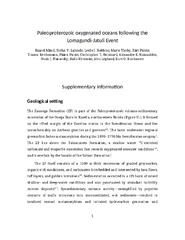Blar i forfatter "Planavsky, Noah J."
-
Chromium evidence for protracted oxygenation during the Paleoproterozoic
Mänd, Kaarel; Planavsky, Noah J.; Porter, Susannah M.; Robbins, Leslie J.; Wang, Changle; Kreitsmann, Timmu; Paiste, Kärt; Paiste, Päärn; Romashkin, Alexander E.; Deines, Yulia E.; Kirsimäe, Kalle; Lepland, Aivo; Konhauser, Kurt O. (Journal article; Tidsskriftartikkel; Peer reviewed, 2022-03-24)It has commonly been proposed that the development of complex life is tied to increases in atmospheric oxygenation. However, there is a conspicuous gap in time between the oxygenation of the atmosphere 2.4 billion years ago (Ga) and the first widely-accepted fossil evidence for complex eukaryotic cells . At present the gap could either represent poor sampling, poor preservation, and/or difficulties ... -
The kaolinite shuttle links the Great Oxidation and Lomagundi events
Hao, Weiduo; Mänd, Kaarel; Li, Yuhao; Alessi, Daniel S.; Somelar, Peeter; Moussavou, Mathieu; Romashkin, Alexander E.; Lepland, Aivo; Kirsimäe, Kalle; Planavsky, Noah J.; Konhauser, Kurt O. (Journal article; Tidsskriftartikkel; Peer reviewed, 2021-05-19)The ~2.22–2.06 Ga Lomagundi Event was the longest positive carbon isotope excursion in Earth’s history and is commonly interpreted to reflect perturbations in continental weathering and the phosphorous cycle. Previous models have focused on mechanisms of increasing phosphorous solubilization during weathering without focusing on transport to the oceans and its dispersion in seawater. Building from ... -
Palaeoproterozoic oxygenated oceans following the Lomagundi–Jatuli Event
Mänd, Kaarel; Lalonde, Stefan V.; Robbins, Leslie J.; Thoby, Marie; Paiste, Kärt; Kreitsmann, Timmu; Paiste, Päärn; Reinhard, Christopher T.; Romashkin, Alexandr E.; Planavsky, Noah J.; Kirsimäe, Kalle; Lepland, Aivo; Konhauser, Kurt O. (Journal article; Tidsskriftartikkel; Peer reviewed, 2020-03-16)The approximately 2,220–2,060 million years old Lomagundi–Jatuli Event was the longest positive carbon isotope excursion in Earth history and is traditionally interpreted to reflect an increased organic carbon burial and a transient rise in atmospheric O<sub>2</sub>. However, it is widely held that O<sub>2</sub> levels collapsed for more than a billion years after this. Here we show that black shales ...


 English
English norsk
norsk

